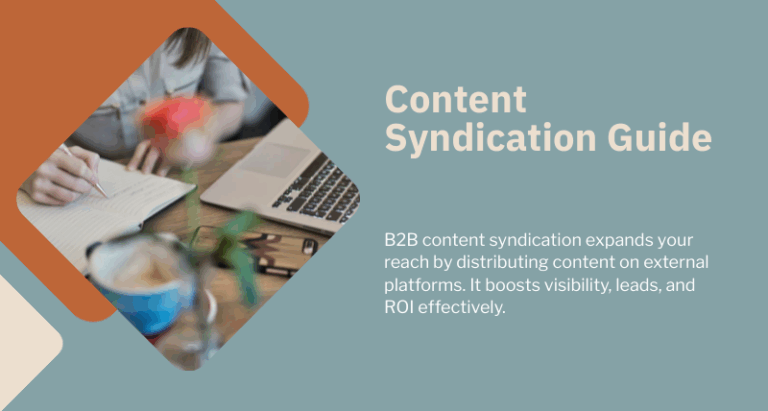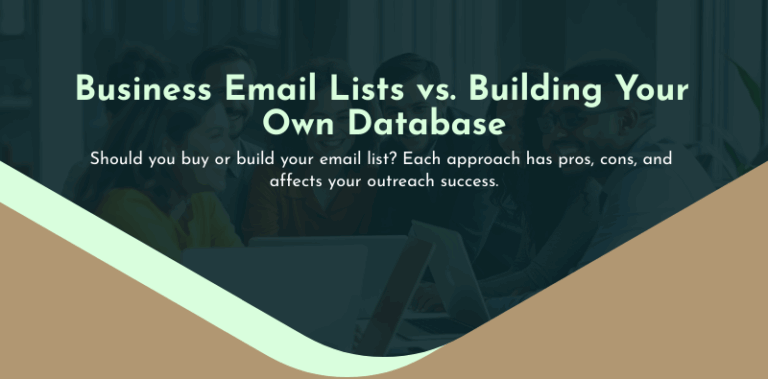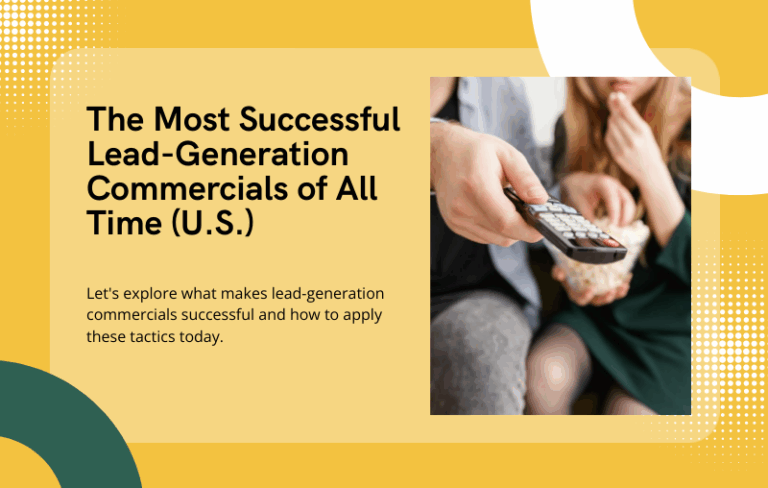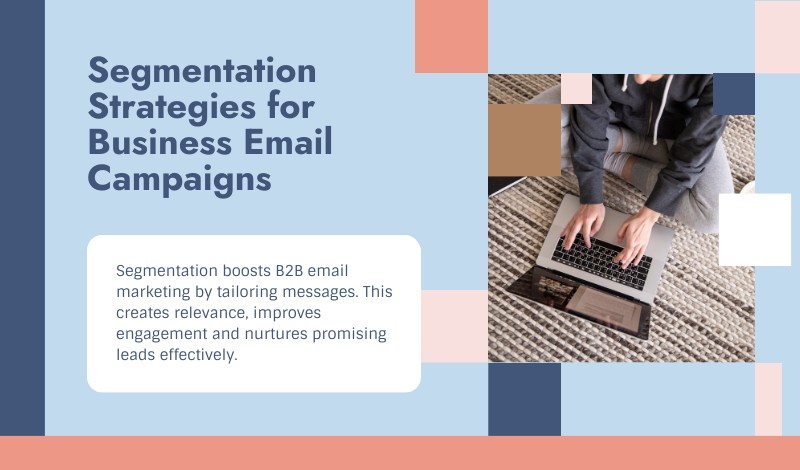
Segmentation has become one of the strongest drivers of success in modern B2B email marketing. With inbox competition growing and buyer expectations rising, companies can no longer rely on broad, generic messaging. B2B audiences want messages tailored to their needs, role, industry, and intent level. Effective segmentation ensures that every recipient receives messages that feel specifically created for them, not for a mass list.
For B2B organizations navigating complex, multi-stakeholder buying cycles, segmentation is essential. It turns email from a one-directional broadcast tool into a dynamic system for nurturing, educating, and converting leads. Strong segmentation email lists improve engagement, relevance, and ROI by bringing precision to every touchpoint.
Why Segmentation Matters in B2B Email Campaigns
Before diving into the specific strategies, it’s essential to understand why segmentation is so valuable in B2B environments. B2B buyers are not impulsive consumers; they research carefully, interact with multiple touchpoints, and often collaborate with a team before making decisions.
Proper segmentation allows you to:
Deliver Content That Matches Buyer Intent
Sending educational content to prospects who are still researching is far more effective than pushing demos too early. Segmentation aligns what you send with what buyers need.
Increase Engagement Metrics
Segmented campaigns consistently produce higher open rates, click-through rates, and conversions because the content feels contextually relevant.
Support Sales Teams With Warmer Leads
By delivering the right email content at the right time, segmentation helps clarify buyer intent. This results in leads who are more prepared for sales conversations.
Reduce Unsubscribes and Spam Complaints
Irrelevant messages are the #1 cause of unsubscribes. Segmentation ensures subscribers only receive messages that make sense for them.
Improve Deliverability
Mailbox providers reward sender reputations tied to high engagement. Healthy segmentation email lists mean fewer ignored messages.
Strengthen Long-Term Customer Relationships
Segmentation is equally powerful post-purchase. Tailored onboarding, renewal reminders, product tips, and upsell communications all benefit from smart segmentation.
In short, segmentation is the backbone of strategic B2B email marketing.
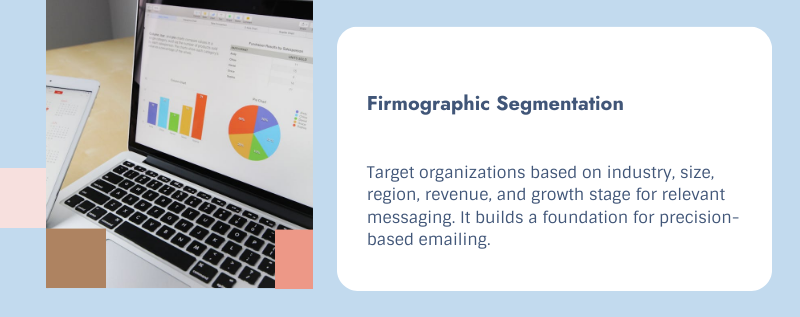
Firmographic Segmentation
Firmographic segmentation focuses on the characteristics of the target organization. In B2B marketing, this is often the first and most influential segmentation layer because different businesses operate under vastly different contexts.
Key Firmographic Data Points
The most effective firmographic categories include:
Industry: Dictates the regulatory environment, challenges, and common workflows.
Company size: Influences budget, internal complexity, and the decision-making hierarchy.
Region: Affects language, compliance requirements, seasonality, and cultural nuances.
Revenue: Helps identify spending capacity and product-tier fit.
Growth stage: Startup vs. enterprise requires distinct messaging approaches.
Why Firmographics Drive Relevance
Industry-specific needs play a huge role in B2B marketing. For example:
- A healthcare organization cares about compliance and data protection.
- A manufacturing company wants efficiency, automation, and reduced downtime.
- A SaaS startup values scalability and ease of implementation.
Firmographic segmentation email lists help marketers tailor subject lines, examples, case studies, and offers, improving resonance and engagement.
Advanced Firmographic Applications
Create industry-specific nurture sequences and resource hubs.
Use sector-focused webinars to drive conversions.
Send case studies that reflect the recipient’s market.
Highlight product features uniquely valuable to certain industries.
Firmographic segmentation builds the foundation for precision-based emailing.
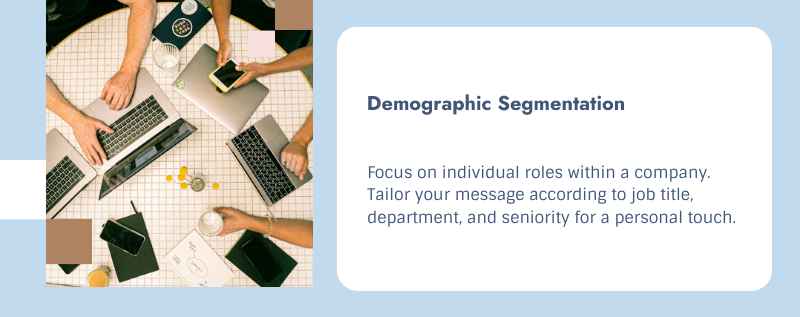
Demographic Segmentation
Demographic segmentation looks at the individual recipient rather than the organization. In B2B email marketing, this is crucial because different roles within a company have distinct priorities and pain points.
Useful Demographic Category Examples
Job Title (Executive vs. Specialist) – High-level leaders want strategic value; operators want practical functionality.
Department (Finance vs. IT vs. Operations) – Each department evaluates your product differently.
Seniority Level – Entry-level staffers want how-to guidance, while executives want ROI and big-picture outcomes.
Decision-making influence – Some recipients are end users, others gatekeepers, others budget holders.
Why Demographic Segmentation Works
Different roles speak different “languages.” For instance:
- CTOs appreciate emails focused on integrations and system reliability.
- CFOs respond to ROI, budgeting, and financial efficiency.
- HR directors look for productivity and employee experience tools.
Segmenting emails by role ensures your message aligns with the recipient’s personal goals, not just their company’s.
Extended Use Cases
- Send executive summaries to C-suite subscribers.
- Deliver tutorials, guides, and how-to videos to hands-on users.
- Provide budget planning templates to finance teams.
With demographic segmentation, campaigns become more human, specific, and persuasive.
Buyer Journey Stage Segmentation
B2B buyers move gradually from problem recognition to final decision. Each stage requires different types of messaging, which makes segmentation by journey stage essential.
Understanding the Buyer Funnel
| Journey Stage | Buyer Mindset | Best Email Types |
| Awareness | Identifying a challenge | Informational blogs, industry insights |
| Consideration | Evaluating options | Webinars, comparison sheets, case studies |
| Decision | Finalizing a choice | Free trials, demos, ROI calculators |
| Retention | Using the product | Training, updates, best practices |
| Expansion | Considering upgrades | Personalized recommendations |
Benefits of Journey Stage Segmentation
- Prevents premature sales pressure
- Supports more effective nurture flows
- Makes lead scoring more accurate
- Reduces drop-off by ensuring timely, relevant content
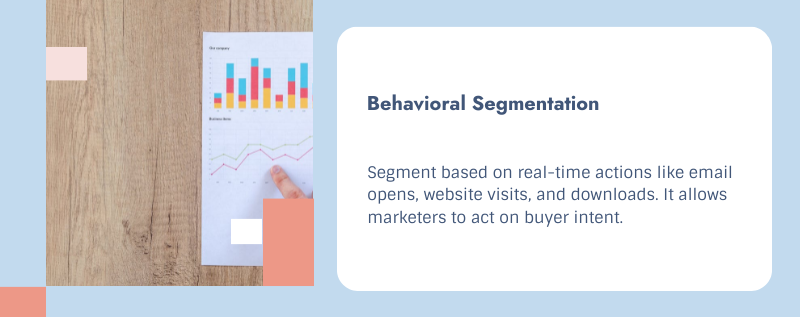
Behavioral Segmentation
Behavioral segmentation is one of the strongest indicators of intent because it captures what the subscriber is genuinely interested in based on their actions.
Types of Behavioral Data
- Email opens and click patterns
- Website browsing behavior
- Resource downloads
- Webinar attendance
- Free trial activity
- Cart or form abandonment
- Recency and frequency of engagement
Why Behavioral Segmentation Is Powerful
It elevates personalization by responding to real-time signals. For example:
- A subscriber who clicks multiple emails about security features should receive more security-related content.
- Users who view pricing pages are signaling buying intent.
- Inactive subscribers may require softer touchpoints or re-engagement sequences.
Expanded Behavioral Segmentation Strategies
- Interest-based nurture tracks triggered by specific content categories.
- Lead scoring models that trigger automated email flows.
- Time-sensitive follow-ups after high-intent actions (e.g., demo requests).
- Re-activation campaigns for cold segments.
Behavioral segmentation email lists allow marketers to act on buyer intent in real time.
Technographic Segmentation
Technographic segmentation focuses on the digital tools, platforms, and systems a company uses. This is particularly effective for SaaS companies and companies selling integrations or workflow tools.
Important Technographic Factors
- CRM system
- Marketing automation software
- ERP or project management tools
- Cloud provider
- Competitor platforms
- Integration requirements
Strategic Advantages
- When you know a prospect’s technology stack, you can:
- Highlight specific integrations your product supports
- Target competitor users with comparison content
- Provide migration guides
- Customize onboarding messaging
Pain Point and Use Case Segmentation
Segmentation by pain point allows you to match your message to the specific challenges your audience is trying to solve. This speaks directly to emotion and urgency.
Common Pain Point Segments
- Reducing operational inefficiencies
- Improving compliance or regulation readiness
- Enhancing analytics visibility
- Automating manual workflows
- Improving customer experience
- Reducing costs or waste
Why This Segmentation Works
Buyers respond emotionally to solutions that alleviate their specific frustrations. Pain-point messaging is highly compelling because it feels personal.
Expanded Use Case Examples
| Segment | Messaging Approach | Email Example |
| Productivity | Workflow automation benefits | “Save 10+ hours weekly with automated tracking” |
| Compliance | Risk mitigation | “Ensure audit readiness with centralized reporting” |
| Customer service | Faster response times | “Improve ticket resolution 22% with integrated tools” |
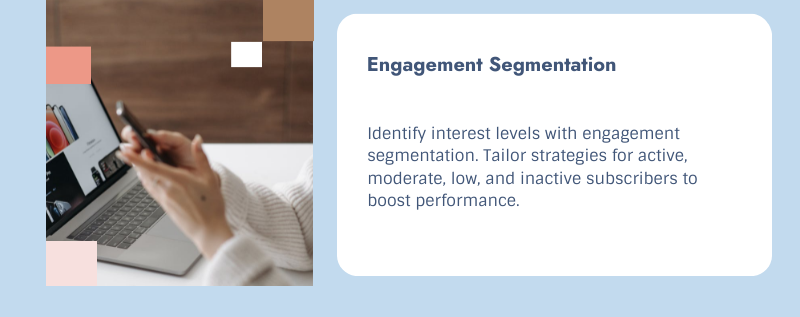
Engagement-Level Segmentation
Not every subscriber interacts with your emails the same way. Engagement segmentation identifies the level of interest and activity within each group.
Engagement Categories
- Active Engagers: Regular opens/clicks
- Moderate Engagers: Intermittent activity
- Low Engagers: Minimal interaction
- Inactive: No engagement past 60–180 days
Why This Matters
Different engagement levels require different strategies. Sending frequent emails to inactive subscribers can harm deliverability.
Expanded Engagement Strategies
Active: Offer demos, case studies, and advanced content
Moderate: Provide more educational guidance and nurturing
Low: Send lighter content and invitations to reconnect
Inactive: Use “last chance to stay subscribed” or incentives
Engagement segmentation email lists protect your sender reputation and strengthen overall performance.
Account-Based Segmentation
Account-based marketing (ABM) emphasizes high-value accounts that require personalized, targeted communication.
Key ABM Segmentation Criteria
- Annual contract value potential
- Strategic importance
- Existing relationship with your brand
- Buying committee composition
- Competitor involvement
Expanded ABM Email Tactics
- Personalized executive emails
- Custom case studies with their industry metrics
- Account-specific product roadmaps
- Tailored ROI projections
- Multi-contact stakeholder email workflows
ABM segmentation supports deep personalization for your most valuable prospects.
Predictive Segmentation With AI
Predictive segmentation uses AI to evaluate buyer likelihoods and segment audiences accordingly.
Predictive Data Points
- Lead score probability
- Churn likelihood
- Upsell potential
- Engagement prediction
- Conversion probability
Why Predictive Segmentation Is Valuable
It allows marketers to:
- Reach leads before they disengage
- Prioritize accounts about to convert
- Personalize content based on predicted interests
- Optimize campaign timing
Expanded Applications
- AI-driven content recommendations
- Dynamic segmentation email lists updated in real time
- Predictive scoring models that trigger automated workflows
Predictive segmentation is becoming a core advantage for data-driven B2B marketers.
Data Collection Strategies for Stronger Segmentation
Segmentation is only as good as the data supporting it.
Core Data Sources
- Website analytics
- CRM records
- Lead capture forms
- Email engagement history
- Sales feedback
- Customer surveys
- Data enrichment tools
Ethical and Effective Data Practices
- Avoid overwhelming users with long forms
- Use progressive profiling to collect data gradually
- Provide transparency about how you use data
- Regularly audit and update data sources
- Maintain compliance with GDPR/CCPA
Better data = better segmentation email lists.

Building and Maintaining Segmentation Email Lists
Segmentation is an evolving process. Lists must remain dynamic as subscribers change roles, industries, needs, and engagement patterns.
Maintenance Practices
- Perform monthly or quarterly list cleaning
- Use automation to update segments based on behavior
- Add preference centers to let users self-segment
- Use analytics to identify underperforming segments
Advanced Maintenance Tactics
- Validate email activity to boost deliverability
- Reassign leads to new segments when roles change
- Combine segmentation rules to refine accuracy
- Retire outdated segments and replace them with data-driven ones
Key Metrics to Assess Segmentation Performance
| Metric | Insight Provided |
| Open Rate | Relevance of subject line & segmentation |
| CTR | Content relevance and clarity |
| Conversion Rate | Segment quality & message alignment |
| Unsubscribes | Misalignment or fatigue |
| List Growth Rate | Overall segmentation health |
Monitoring these indicators strengthens long-term success.
Implementing Segmentation Strategies for Email Campaigns
Strong segmentation is no longer optional in B2B email marketing but it is essential for success. As buying cycles grow more complex and buyer expectations evolve, companies must deliver messaging tailored to industry, role, intent, behavior, and engagement level. Effective segmentation email lists give marketers the ability to speak directly to the needs of each audience segment, driving better ROI, stronger engagement, and more meaningful customer relationships.
By applying firmographic, demographic, technographic, behavioral, and journey-stage segmentation, plus advanced tactics like ABM and predictive modeling, organizations can build targeted email ecosystems that adapt to each user. With the right data and continuous refinement, segmentation becomes a strategic advantage that transforms email from a mass communication tool into a personalized growth engine.
FAQs – Segmentation Strategies for Business Email Campaigns
1. What is segmentation in B2B email marketing?
Segmentation divides subscribers into groups based on shared traits, behaviors, or needs so you can send more personalized messages.
2. Why are segmentation email lists important?
They improve engagement, reduce unsubscribes, increase conversions, and strengthen relevance.
3. How many segments should a business have?
Start small with 3–5. Add more segments as your data becomes richer and your strategy matures.
4. What is the difference between firmographic and demographic segmentation?
Firmographics focus on the company; demographics focus on the individual recipient’s role and responsibilities.
5. Does segmentation boost email deliverability?
Yes. More relevant content increases engagement, which mailbox providers reward.
6. How does segmentation help with long sales cycles?
It aligns email content with the buyer’s journey stage, reducing drop-off and nurturing leads more effectively.
7. What tools support segmentation?
CRM systems, marketing automation platforms, and data enrichment tools.
8. Can segmentation be automated?
Absolutely. Behavioral triggers, CRM syncing, and AI-driven models can update segments automatically.
9. Should inactive subscribers be removed from lists?
If they remain unengaged after re-engagement attempts, removing them protects deliverability.
10. What is the most effective segmentation type?
Behavioral segmentation is often the strongest indicator of intent, but combining multiple types produces the best results.
